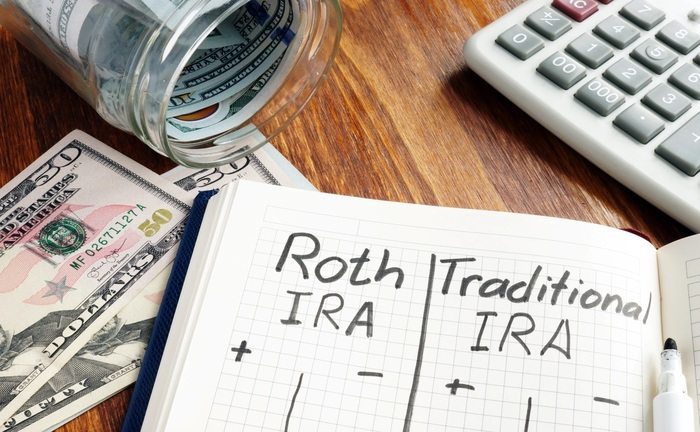Banks are increasingly offering bank account alternatives so their customers can save for the future or manage their finances without relying only on cash.
This money saved is deposited in the accounts of each owner, who, depending on their employment status and age, can access two versions, in particular: the savings account and the Roth IRA. Both have benefits and different purposes, depending on various aspects of the client.
What is a Saving Account?
Bank customers most widely use savings accounts, as it is the traditional and safest version of saving, depositing, and withdrawing your money quickly and without complications.
As you receive deposits in your savings account, you will be charged interest, which varies according to the bank to which you belong and also depends on each service or product for which these fees are generated.
On the other hand, savings accounts allow you to access your money anytime, thanks to your debit card. You can carry out different transactions, such as cash withdrawals at ATMs, payments in commercial businesses, etc.
Undoubtedly, this bank account is one of the easiest to use and, therefore, is the one that most people choose to keep their money in, due not only to its ease but also to its speed in transactions.

What is a Roth IRA Account?
The Roth IRA is like a savings account but intended for retirees to access their banking transactions without complications, such as withdrawing money without being taxed. That is only for those who have already had a Roth account for five or more years and who are over 50 and a half years of age (which varies according to each State).
IRA owners pay a certain amount for contributions and annual account maintenance. What differentiates Roth IRAs from basic and traditional IRAs is that they do not need to pay for the money mentioned above but can leave it in their account and name a future heir and beneficiary.
What do Roth IRAs and savings accounts have in common?
A savings account is a simple and easy way to get cash. On the other hand, the Roth IRA is dedicated to retirees with savings in their bills so they can access them anytime.
Since it is money that has been contributed throughout their working life, the retiree has tax advantages, i.e., they will not be penalized for having accessed their savings since they are “emergency funds“. However, you will be charged a 10% early withdrawal fee for the contributions.
The Roth IRA allows you to withdraw these emergency funds whenever the beneficiary wants or needs them, but there are two tricky points to remember for those with a Roth IRA:
- Contribution limit per year: The contribution limit for a Roth IRA is estimated to be $6,500 (by 2024) for those under age 50 and $7,500 for those over age 51.
- No subsequent deposit: Those who have withdrawn money from their Roth account will not be able to re-deposit to replenish their retirement savings. While this point is strict, a short-term loan can be requested and deposited into the Roth IRA within 60 business days. This process can only be done once a year and is called an “IRA Rollover”.
Roth IRA vs. Savings Account Comparison
As mentioned, savings accounts and Roth IRAs are ways to save money, and each has different goals, limits, taxes, returns, and types of investments.
| Type of Account | IRA Roth | Savings Account |
| Contribution cap | The government establishes annual contribution limits, so you should verify this information with your bank. | There are no limitations except the government insurance limit ($250,000). |
| Objective | To save money for retirement. | Save for emergencies and short and medium-term objectives. |
| Return | Not insured, but has higher returns over the years. | The government insures it, but its returns are low. |
| Taxes | Contribute in taxable dollars (can be withdrawn without paying taxes). | Taxes must be paid with interest. |
| Type of investment | Invest in stocks, real estate, bonds, etc. | It does not allow investment, but cash can be withdrawn anytime. |
Is a savings account better than a Roth IRA?
Roth IRAs are savings accounts for retirement for those under age 59 who meet specific requirements and who may need to withdraw earnings tax-free. In other words, if you want to invest money for the long term, Roth IRAs are ideal for these savings. However, a commission or taxes are charged to withdraw if the conditions agreed upon for the withdrawal still need to be met.
On the other hand, savings accounts provide ease and security when making medium and short-term investments since the money is saved so that it does not get lost and can be used later on.
In conclusion, both accounts are suitable, depending on each person’s intention. If you want to save in the long term, it is better to opt for a Roth IRA, while if you want to keep in the short or medium term, it is advisable to opt for a savings account.
References
- Baluch, Anna. “Roth IRA vs. Savings Account: What’s the Difference?” The Balance, The Balance, 1 Apr. 2022, https://www.thebalancemoney.com/roth-ira-vs-savings-account-whats-the-difference-5224422.
- Porter, Thomas (TJ). “Savings Account vs. Roth IRA: Which Is Better for Savings? | MyBankTracker.” MyBankTracker, MyBankTracker, 20 Mar. 2017, https://www.mybanktracker.com/savings/faq/savings-account-vs-roth-ira-266333#:~:text=Savings%20accounts%20are%20incredibly%20safe,riskier%2C%20long%2Dterm%20investments.
- “Tipos de Cuentas Bancarias – Qué Es Una Cuenta de Cheques y de Ahorros – Wells Fargo.” Wells Fargo Bank | Financial Services & Online Banking, https://www.wellsfargo.com/es/financial-education/basic-finances/manage-money/options/bank-account-types/.
- “What Is an IRA (Individual Retirement Account) and How to Choose One?” Better Money Habits, Bank of America, 27 Apr. 2022, https://bettermoneyhabits.bankofamerica.com/en/retirement/what-is-an-ira.


